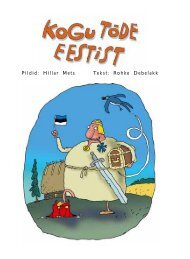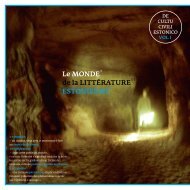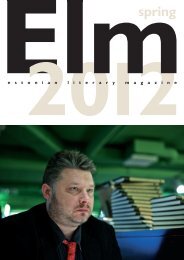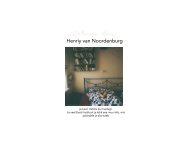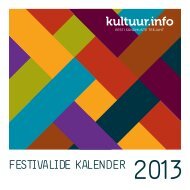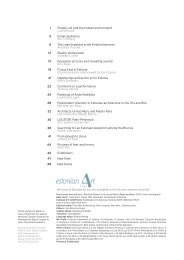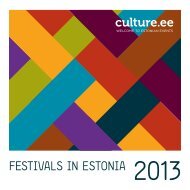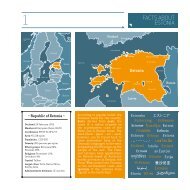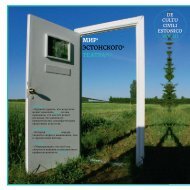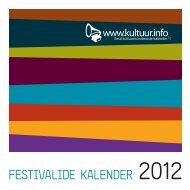Autumn 2013
Autumn 2013
Autumn 2013
You also want an ePaper? Increase the reach of your titles
YUMPU automatically turns print PDFs into web optimized ePapers that Google loves.
element, wishes and fantasies deposited in<br />
the subconscious in childhood, feeds the<br />
men’s complexes and eats away at their<br />
respectable and conscious image of self.<br />
This is therefore clearly a novel of men:<br />
clinging to young women and intoxicated<br />
with new experiences, the analyses of<br />
emotional reflections from the partners’<br />
points of view are modest, except for the<br />
epistolary romance, which introduces the<br />
woman’s side as well. This relationship is the<br />
most clearly and compactly described.<br />
The author of the book, Mart Kadastik<br />
(born in 1955), has worked in journalism for<br />
a long time and is the head of one of the<br />
largest media corporations in Estonia.<br />
Kadastik’s style is occasionally highly<br />
baroque, and the novel has been accused of<br />
waffling. Still, the verbal vibrancy is captivating<br />
and is balanced by the journalistic<br />
neutrality, almost tepidness, with which the<br />
author describes the intimate reflections,<br />
erotic images and adventures of respectable<br />
men. The style reveals conscious swings<br />
between closeness to life and a literary<br />
touch: convincing sincerity is blended with<br />
prickling irony, which can even veer into the<br />
grotesque. In sum, Spring Arrives in <strong>Autumn</strong><br />
is a mature, pretentious, intellectual debut<br />
novel. BM<br />
Mihkel Mutt<br />
Kooparahvas läheb ajalukku<br />
(The Cavemen Go Down in History)<br />
Tallinn, Fabian, 2012. pp. 462<br />
ISBN: 9789949933600<br />
Mihkel Mutt’s (b. 1953) latest novel,<br />
Kooparahvas läheb ajalukku (The Cavemen<br />
Go Down in History), reflects the life of the<br />
Estonian cultural elite from 1960 to 2010. It<br />
describes how the position of Estonian<br />
culture changed with the restoration of<br />
Estonian independence and what exactly<br />
happened to our society during that process.<br />
The creative intelligentsia – writers, artists,<br />
Mihkel Mutt (Photo by Scanpix)<br />
musicians, theatre people and humanitarians<br />
– played a vital role in resisting Soviet<br />
rule. After the change of power, it soon<br />
became clear that the desired freedom had<br />
brought with it a great deal of uncertainty<br />
for cultural figures. Most of them failed to<br />
adapt to the new situation, and that led to<br />
scepticism and disappointment. How did<br />
those who managed to fit into the new<br />
system find a balance between the values<br />
they used to live by and the values they<br />
now had to follow? Why did everything end<br />
up the way it did?<br />
As the pages fly by we meet dozens of<br />
colorful characters, all members of the<br />
Estonian cultural elite. The central meeting<br />
point of these characters is a pub located in<br />
the heart of Tallinn. The pub is called The<br />
Cave, and readers will recognize this as the<br />
famous Kuku Club. Fictionalising prominent<br />
people always creates a desire to recognize



